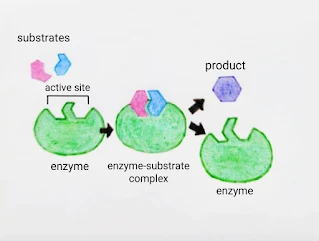Effects of enzymes on aging and related diseases
Enzymes
 |
| How enzyme catalyze a chemical reaction |
Enzymes are biological catalysts, catalysts are those substances which can alter the speed of chemical reactions.There are positive and negative catalysts,positive catalysts speed up chemical reactions where as negative catalysts decreases the rate of chemical reactions.Enzymes are positive catalysts, which accelerate chemical reactions in our body.Enzymes are basically proteins,made up of long chains of amino acids.Enzymes are discovered in 1897 by a German biochemist Eduard Buchner, he got Nobel prize in chemistry in 1907 for his discovery of cell-free fermentation. He showed that an enzyme named zymase extracted from yeast cells can break up sugar into alcohol and carbon dioxide.There are about 40,000 different enzymes present in our body (these number may increase because every day new enzymes are discovering )each enzyme catalyze a different chemical reaction.In 1980 Sidney Altman and Thomas R.Cech found that some RNAs have the ability to catalyze specific bio chemical reactions,these RNAs are called Ribozymes.Ribozymes are made up of nucleic acids not proteins.Both Sidney Altman and Thomas R.Cech were professors of Yale University(USA) and University of Colorado(USA) respectively,they were jointly awarded the Nobel prize for chemistry in the year 1989.So it is cleared that thre are some other biological catalysts also present in our body other than protein based enzymes
.
Digestive enzymes
Digestive enzymes are produced by the organs of our digestive system.Amylase and lingual lipase present in saliva, trypsine, pancreatic amylase and pancreatic lipase are the secretion of pacrease, Deoxynuclease and deoxyribonuclease also produced in pacrease.pepsin produced in the stomach
Amylase: breaks down large starch molecules into smaller sugar molecules.
Lipase: breaks lipids into glycerol and fatty acids.
Protease: breaks down proteins in to amino acids.
Trypsine : also breaks down protein
Lactase:(found in small intestine) breaks lactose, the milk sugar into glucose and galactose .
Deoxyribonuclease and Ribonuclease helps to breaks bonds in nucleic acids such as DNA and RNA
Metabolic enzymes
Oxydoreductases,dehydrogenases,kinases,lyases,lipoxygenases etc.
Enzymatic process
Active site is a specific region of enzyme,substrate binds to that specific region and form enzyme substrate complex,the substrate is then combined with another molecule or broken down to form enzyme product complex,finally enzyme releases the product and return to its original shape and size.These actions are quick,the speed of the reaction is based on turnover number of enzyme.The
turnover number is the number of substrate molecules converted by one molecule of enzyme per second (when enough substrate molecules are present).The turn over number starting from 0.5 to 600000, defferent enzyme has different turn over numbers.Enzymes are sensitive to temperature and pH values, an optimum temperature and optimum pH value are necessary for maximum activity,
The optimum temperature is around 98.6 Fahrenheit and most of the enzyme’s optimum pH is nearly neutral but pepsin a digestive enzyme work in high aciditic conditions ,its optimum pH value is 2.
Role of enzymes on aging
We know that enzymes are so important,without enzyme no energy no metabolism and even know life.But scientists discovered some adverse effect of enzymes that lead us early aging,immune disorders and diseases like cancer. some examples are given below,
* Thymus a tiny gland,( lies in the chest between lungs and behind sternum) plays an important role in our immune system. It produced some hormones such as melatonine,insuline etc also act as a class room for T cells.T cells are produced in the born marrow but they mature in thymus,there they are trained to recognize antigen.T cells protect us from infections , immune disorders, cancer etc.After puberty stage thymus start to shrink slowly and replaced by fatty tissue, this process is called involution, Afer the age of 65 there a scarcity of T cells in our body. some scientists are on the view that thimus involution may be a form of programmed aging.
It is noted that deletion of PAPPA in mice leads to lifespan extension by 30%.What is PAPPA?,pregnancy associated plasma protein-A (PAPPA) is a protein based enzyme that controls the availability of local insuline-like growth factor(IGF).IGF is required for embryonic and post natal growth.A reduced IGF signaling can increase the life span.A study conducted by Dr.Abbé de vellego(University of Pittsburgh school of medicine) and his team on a mouse Shows that thymus gland of the mouse remain intact through out life after deleted the enzyme PAPPA.This discovery give us a little hope that we can restore the functions of thymus in our entire life.
** Professor Shinji Kamada and Taiki Nagamo (Kobe university research team) discovered that certain enzymes such as DAO promote cellular senencese. D-Amino Acid Oxidise (DAO) is an enzyme that catalyse the oxidisation of D-amino acid to amino acid,but at the same time ROS(Reactive Oxygen Species) produced as a by product,the ROS causes DNA damage,cellular senescence(complete arrest of cell growth) and aging.
*** Alzheimer’s disease is considered as a hereditary disease, which slowly destroy memory and thinking skill.Beta amyloid plaque is building on and around neurons in brain .A team of reserchers from Cleveland Clinic Lerner Research Institute have found that ,the beta amyloid peptide deposits can be reversible by depleting an enzyme BASE1.This Enzyme helping to form beta amyloid peptide .The test was conducted in the brain of mice with Alzheimer’s disease.
Conclusion
Enzymes catalyse thousands of chemical reactions in our body every day. Enzymatic reactions can be noticed in digestion,respiration, reproduction,blood coagulation, and more.production of enzymes declined as we age.we have limited knowledge about enzymes and their activities in our body.we should focus on enzymes to find a proper solution to control aging and related diseases, I hope it is possible in near future.